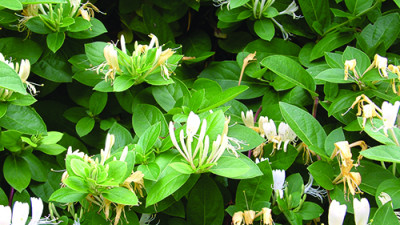
Aaron says the pest plant species targeted for control were chosen specifically for the damage they do to the forest.
Tumutumu Kaitiaki Taiao is strategically picking its battles on Te Aroha Maunga as part of a long-term vision to restore the ngahere to how it historically was – flourishing with native plant and bird life.
For the last three years, the restoration project team has been targeting English ivy, wild ginger, Japanese honeysuckle, tradescantia and climbing asparagus on the lower, western side of the maunga – or as project manager Aaron Taylor calls them, the “creepers, the crawlers, the smotherers and the stranglers”.
Taylor, who is part of a team of four, says there were walls of ivy and honeysuckle hanging from the forest trees, and vast carpets of tradescantia and wild ginger underfoot, when the restoration project first started in 2021.
“We’ve really managed to get some good results with these pest plants, especially the climbing asparagus and wild ginger,” says Aaron.
“Even the DOC ranger who has 50 plus years’ experience here on the maunga said he couldn’t find any – and to me, that’s a huge achievement.”
Tumutumu Kaitiaki Taiao was started in 2021 with Jobs for Nature funding, which was distributed by the Manaaki Kaimai Mamaku Trust to 12 iwi-hapū projects within the Kaimai Mamaku Forest Park.

It takes about five or six rounds of control to get on top of wild ginger.
In September, Waikato Regional Council granted the project $40,000 over two years towards practical field labour, including pest plant control and monitoring.
“When we started out, our aim was to eradicate these targeted pest plant species and they were chosen specifically for the damage that they do to the forest,” says Aaron.
“Ivy, climbing asparagus and Japanese honeysuckle are climbers that can take over the canopy and become heavy enough to damage trees. I’ve seen ivy trunks as big as your leg in here, and they just wind around big trees and strangle them.”
“Tradescantia and wild ginger will totally take over the forest floor and prevent the next generations of native plants from establishing. The ginger alone is just relentless as it grows back again after a couple of months, so it takes about five or six goes to get on top of it.”
The project area is 600 hectares split across two blocks at Waiorongomai and Te Aroha that border popular walking tracks.
It has been divided into grids, which are recorded on a digital GIS platform and checked regularly for pest plant regrowth. Any regrowth is then factored into the work programme.

There were walls of Japanese honeysuckle hanging from the forest when Tumutumu Kaitiaki Taiao started eradicating the pest plant.
While the first few years has been “boots on the ground”, controlling pest plants, the project is now starting to diversify.
Tumutumu Kaitiaki Taiao has been partnering with Matamata Piako District Council’s Kaimai Valley Services to complete native restoration planting on the Te Aroha Domain track and with Tiakina Kauri to build and divert tracks to mitigate the threat of kauri disease.
“We are getting really good feedback from the people who are regulars in the bush, and they’re saying that the mauri of the ngahere has significantly improved,” says Aaron.
“And it’s also really great to get extra funding in recognition of all the work we have done.
“We need to be able to keep on top of the gains we’ve made if we are to fully restore the maunga to its former glory.”



To ask for help or report a problem, contact us
Tell us how we can improve the information on this page. (optional)